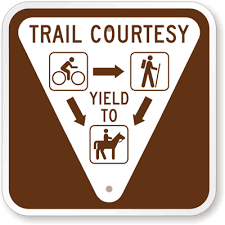ABC Quick Check: The Rest of the Story
The “ABC Quick Check” is a phrase to help you remember how to
check your bike for safety and mechanical soundness. Previous posts discussed the first two letters, which stand for Air and Brakes. Today we bring you "the rest of the story".
If your chain is too rusty, you will probably need a new one. Otherwise, you can probably just lubricate it. What should you use? There are various opinions on this question, but all mechanics agree on one thing: Do not use WD-40! Why? WD-40 is a de-greasing solvent. It will actually remove any other lubrication your chain may have, and then quickly dry it out.
Beyond that caveat, I don't have a strong preference. Bike shops sell various types of chain lube, and can recommend one for your bike and the type of riding you do. On the lower end, I typically just use 3-in-1 oil available at any hardware store, and I haven't noticed any problems.
If your chain isn't that bad, but it doesn't run well backwards, your gearing equipment may need to be adjusted. Take your bike to the bike shop to have that looked at. Chains can also stretch with use, requiring replacement. Using a stretched chain for too long can also shorten the life of the front and rear cogs.
As with the chain, make sure that the cassette is clean and has some lubrication on it. We can extend this chain/cassette category to include the drivetrain in general, including the front cog(s) (technically called "chain rings"), and all the moving parts of the derailleurs. Keep them all lubricated.
Now we finally leave the beginning of the alphabet and skip directly to...
How tight? Just shy of so tight that you can't get it off again. The definition I go by is, just tight enough to leave a mark on your palm when you close it, without hurting. That should hold it tight.
Two more meanings for the word "quick":
Next time: An important street riding safety tip!
<<< Previous Post: B is for Brakes Why This Blog?
C is for Chain
Check that the chain is clean and lubricated. If you have a bike that you can pedal backwards (that is, not a coaster brake or "fixed gear"), try running the chain backwards while holding the bike stationary to make sure it runs smoothly. (If the gears have been shifted while stopped, you might have to get the bike properly into gear first by lifting the back wheel and moving the pedals forward until the chain gets onto the correct cog.)If your chain is too rusty, you will probably need a new one. Otherwise, you can probably just lubricate it. What should you use? There are various opinions on this question, but all mechanics agree on one thing: Do not use WD-40! Why? WD-40 is a de-greasing solvent. It will actually remove any other lubrication your chain may have, and then quickly dry it out.
Beyond that caveat, I don't have a strong preference. Bike shops sell various types of chain lube, and can recommend one for your bike and the type of riding you do. On the lower end, I typically just use 3-in-1 oil available at any hardware store, and I haven't noticed any problems.
If your chain isn't that bad, but it doesn't run well backwards, your gearing equipment may need to be adjusted. Take your bike to the bike shop to have that looked at. Chains can also stretch with use, requiring replacement. Using a stretched chain for too long can also shorten the life of the front and rear cogs.
C is for Cassette
What's a cassette? Besides those compact reel-to-reel audio tapes that my generation listened to music on, it's also the technical term for the set of cogs on the rear wheel. |
| A bicycle cassette (set of rear cogs) |
As with the chain, make sure that the cassette is clean and has some lubrication on it. We can extend this chain/cassette category to include the drivetrain in general, including the front cog(s) (technically called "chain rings"), and all the moving parts of the derailleurs. Keep them all lubricated.
C is for Crank
Hey, how many C's are there, anyway? The "cranks", the arms that extend from the front cog to the pedals, are also part of the drivetrain. ("D" is for drivetrain?) What you want to check here are that the cranks don't have any side-to-side wobble. They should have only the normal forward and backwards circular movement. If they're loose, get that checked out by your local bike shop. (You may need work on your "bottom bracket" - two more B's!)Now we finally leave the beginning of the alphabet and skip directly to...
"Quick" is for Quick Release
Many bikes feature quick release seatposts, and some adult bikes also have quick release wheels. The quick release lever makes it easy to take these things on and off without tools. Make sure that each lever is completely closed (close to but not quite touching the frame). |
| A quick release lever in a properly closed position |
How tight? Just shy of so tight that you can't get it off again. The definition I go by is, just tight enough to leave a mark on your palm when you close it, without hurting. That should hold it tight.
Two more meanings for the word "quick":
- Finish with a quick general look over the rest of your bike, for any loose screws or other suspicious looking things.
- The entire ABC Quick Check is really pretty quick to do! Best to do it every time you use your bike, especially if you don't use it every day. Certainly after having it in storage for a while.
Next time: An important street riding safety tip!
<<< Previous Post: B is for Brakes Why This Blog?



Comments
Post a Comment